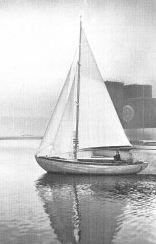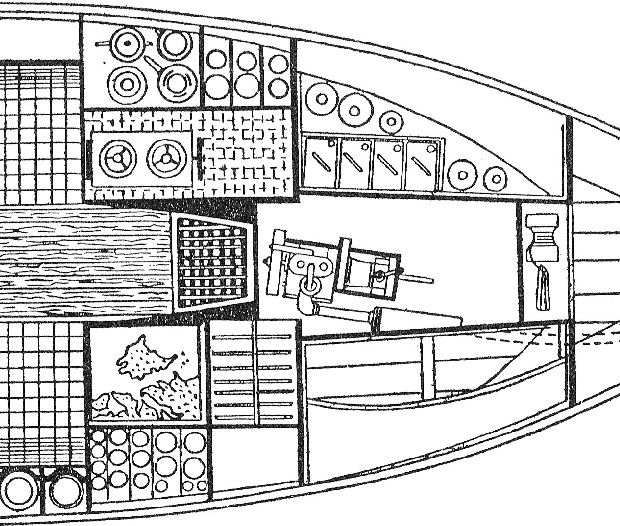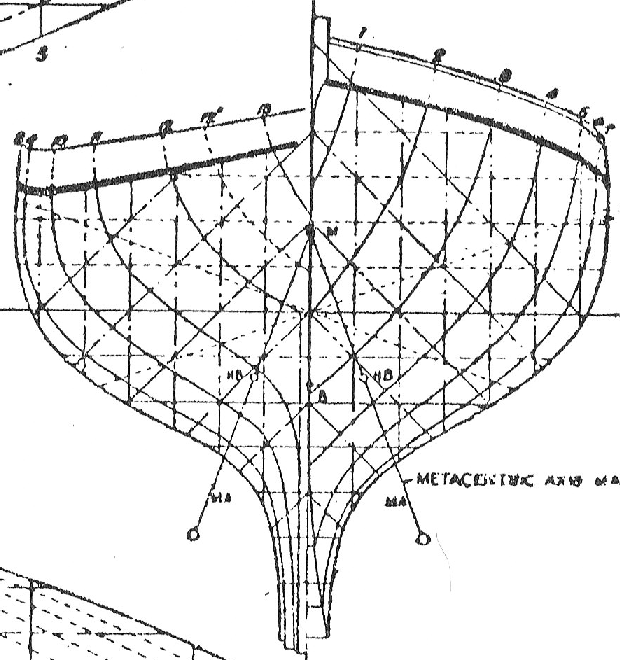| |
The Relaunch Article
The article with which the magazine is being relaunched is about a Harrison Butler boat called Amiri which has been in the loving care of David and Elizabeth Stamp for the last twenty-two years. They sail her in Australian waters, out of Melbourne. What makes Amiri particularly interesting is that she is built to the Sinah design of 1935. The significance of this is that it is the Sinah design that features heavily throughout Cruising Yachts: Design and Performance, written by Harrison Butler immediately before his death in 1945. In each chapter the Sinah design is used as a specific example to illustrate the general principles and philosophies which Harrison Butler had come to believe the perfect yacht should embrace. Sinah represents a cullmination of a lifetime's train of thought. This makes Amiri an ideal boat to investigate how a perfected design was implemented in practice, and how it has further evolved to remain useable in 2014. I hope readers will be sufficiently inspired by the article to want to know more about Harrison Butler's designs. There is no finer starting point than Cruising Yachts: Design and Performance.
Design & Reality
Harrison Butler Perfected
by
David & Elizabeth Stamp
Harrison Butler and his boats
Thomas Harrison Butler, or THB as we shall often refer to him, was a prominent ophthalmic surgeon. His two main hobbies were designing cruising yachts and sailing. He was actively designing in the first half of the twentieth century, producing in excess of a hundred designs. He considered some of his early works to be experiments; not to be kept and not to used as serious blueprints for boat construction. Once a design had evolved sufficiently he sought to publish it. Often this was in the various yachting magazines of the day, sometimes as a competition entry. He frequently won first prize.
The oldest known THB boat, still sailing, is Memory which was built in 1912 to a design published in Yachting Monthly in 1911. Our boat, Amiri, was built in 1976. She is one of two boats built to THB's Sinah design of 1935. The other, Erla, was built in Denmark in 1938. World-wide, over a hundred boats built to THB designs are still sailing.

Erla, 1938
Metacentric Analysis
One of Harrison Butler’s major aims was to produce a hull form that would retain good helm balance at any angle of heel. Achieving this was a lifelong iterative process of trial and improvement. Increasingly, THB sought to underpin his designs with a sound body of mathematical knowledge that came to be known as metacentric analysis. His well-balanced boats of the 1930s and 1940s were in marked contrast to the other small yachts of the period which were built largely by eye and with the minimum of formalised design.

Erla's wooden hull under construction.
Amiri was built, also of wood, almost forty years later on the other side of the globe.
These are the only known boats built from THB's Sinah design
The stuff of which Amiri is made
Amiri was built of wood by John Hartley of Bulleen, Melbourne. She has a canoe stern, a feature favoured by Harrison Butler in many of his later designs. Essential details are; LOA 9.45 m, beam 2.7 m, draught 1.5 m, displacement 6.5 tons, or about 8 tons Thames Measurement.
The materials used in Amiri's construction are ironbark for the centre-line structure; spotted gum for the steamed and laminated ribs; iroko (an African hardwood, nearly as durable as teak) for the planking below the water-line, deck beams, cabin structure, and much of the internal fit-out; white (Queensland) beech for the topsides and laid deck; oregon for the bilge stringers and deck-beam shelves; coachwood ply for the bulkheads, cockpit, cabin top, internal furniture and structural deck.
Dynel sheathing was applied to the cabin top, exposed cockpit surfaces and to the plywood deck before beech planks were fitted on top. This Dynal sheathing is to prevent water finding its way into the plywood. The hull planks are narrow, and are fastened to the ribs in the traditional wooden boat-builder's manner with copper rivets and roves. The planks are edge-fastened to each other with monel grip-fast nails. The seams between planks are almost non-existent, with red-lead paint alone being the sealing medium. The rebates along the stem-post, keel and stern-post are caulked and stopped in the conventional manner. Amiri's ballast keel is of cast iron, fixed to the hull with galvanised steel bolts.
A year or so ago we met John Hartley’s riveting assistant, then a student about to start his university course. He told us that his job was to fit the roves over the copper nails, and then cut the nails to length before peening the ends over while John held the heavy dolly against the nail heads on the outside of the hull. This experience gave him extra incentive to study to become an economist rather than a boat-builder !
His love of Harrison Butler boats was not extinguished by the trauma of building one. In recent times he has become the owner of Dream of Arden, moored at Geelong on Port Phillip, and also designed by THB.

Details from THB's Sinah design:
The engine is offset with the propeller on the port side whereas it's centred on Amiri.
The plan shows the galley to starboard, chart table to port. These are swapped in Amiri.
THB's drawings contain unexpected details such as, in this case,
a chart of The Isle of Wright on the chart table; Not to be used for Navigation !
Can you spot the trailing log ?
Deviations from the design
The original plan of the Sinah design shows a narrow cabin top, with correspondingly wide side-decks. Also shown is the cabin front located behind the keel-stepped mast, an offset propeller shaft for the small auxiliary engine, and a fractional cutter rig with narrow headsails and a loose-footed mainsail (back to the future, perhaps). Amiri’s cabin is wider than the original, and extends forward of the mast, and the engine and shaft are on the centre-line. The sliding main hatch, unlike on the design, is offset to starboard to give more space in the galley to port below. Our newish mainsail is fully-battened, there is a single roller-reefing headsail, and a small heavy-weather jib can be set with piston hanks from a demountable inner forestay. Spars are of aluminium, not wood. The single-spreader mast is stepped on deck, and a compression post, combined with the main bulkhead under the mast-step, transfers the mast load to the keel.
Engine upgrades; moving with the times
The original plan suggests that the engine would have been an eight horsepower Stuart Turner two-stroke. When Amiri came to us she had a 12 hp single cylinder Yanmar diesel, and about twenty years ago we replaced it with a 27 hp Yanmar 3GM30 diesel. This involved making a new steel sub-frame to match the new engine’s mounting feet, a new glass/vinylester muffler to fit under the propeller shaft coupling (the only place where it could be made to fit, and it ended up looking a bit like a gumboot), a new propeller and shaft, and a new and modified electrical system. The first and almost most difficult part was to cajole our son into tracing onto a piece of wood the outline of the propeller aperture with the boat in the water during the middle of winter. We needed to make sure it could accommodate a larger propeller.

In THB's design the mast is keel stepped
and the heads are tucked in under the fold-down trapezoidal pipe cot.
On Amiri, the mast is stepped on deck, a bulkhead underneath providing support,
and the heads are enclosed with a wash basin in a small cabin.
Expectations of privacy when on the toilet have increased since 1935 !
The addition of modern comforts
Amiri’s below-deck accommodation consists of a quarter berth to starboard, then a chart table with electric refrigerator under it with access from above, and vertical chart stowage in a narrow compartment inboard of the refrigerator space. Above the chart table is a shelf for the radio and chart plotter. When using paper charts we find our old ex-RAF parallel linkage plotting arm very useful for, among other things, magnetic variation can be compensated for. This allows all plotting to be done in magnetic degrees. Opposite the quarter berth and chart table is a good-sized galley with a two-burner paraffin stove arranged for athwartship swinging, and locking upright when the boat is not heeling. There is the usual sink, plate and cup racks and plenty of storage space. Further forward is the saloon terminating at the bulkhead associated with the mast support post. There are two settee berths, a fixed table with a hinged leaf on one side, a bookshelf, and more lockers. We have modified the table so that the sides overhang the settees by about 50mm; this provides comfortable seating for dining, and is a feature not readily available with conventional tables that are lowered to form a part of sleeping berths. The otherwise original table is long enough for two people each side, and can be extended aft to provide seating for six. Water is carried in flexible tanks under the settees. Lighting internally is by electric LED technology although, in a nod to the past, the saloon can still be lit by paraffin lamps.

The original rig (left) and Amiri's today (right)
One set of spreaders is the most obvious simplification and Amiri's mast
is of hollow alluminium rather than solid wood.
Furthermore, Amiri's modern sails are far lighter than the (often wet) canvas
sails of yesteryear that Harrison Butler would have allowed for in his design.
Would THB have approved of the changes ?
Here is what he had to say on the matter in Crusing Yachts: Design and Performance;
“Any weight we can save in mast and
gear adds largely to stability. In the case of Sinah, I calculate that
if we can save twenty pounds in the weight of the mast it
is equal to a hundredweight of lead keel.
This simple fact gives cause for deep thought !”
Digesting the news
Moving for'ard, we have the enclosed loo with its own wash basin to port, and not quite enough width in which to read a broadsheet newspaper. Opposite, to starboard, is a narrow hanging locker, a set of drawers for personal gear, and a stowage bin underneath. The forward hatch is above this area, in the cabin-top. In the forepeak, and under the fore-deck, is a largeish triangular berth with shelves along and above its sides and stowage underneath for sails, an anchor, warps and 60 m of 10 mm anchor chain.
Deck hardware is fairly simple; a combined forestay fitting/anchor chain fairlead, a manually-operated anchor windlass with gypsy and a warping drum, bottom-action halyard and reefing winches on the mast, two large (for the boat) jib sheet winches, and an endless two-ratio mainsheet system. There is also a collapsible spray dodger, tiller steering, Autohelm 1000 auto-pilot, and Navik wind-steering gear.

Some detail from Harrison Butler's completed Sinah design.
Left is the end elevation of the canoe stern and right that of the bow.
Ribs are numbered from 1 (bow) to 14 (stern).
The words “Metacentric Axis” can (just) be seen.
Sinah was the first of THB's designs to be subjected to metacentric analysis.
The final verdict
Amiri has served us very well over the years, and we try to satisfy her needs as they arise. So far we have been able to carry out all but a very minor part of annual and continuing maintenance ourselves, and we have not found that looking after a wooden boat has put too much of a demand on our time or skills. Harrison Butler's ambition to arrive at a design that is easily handled has been fully met. In most conditions the helm is light and responsive. With the right encouragement, Amiri can sail herself, and has done so often.
David and Elizabeth Stamp
Journal of The Harrison Butler Association
Issue 71, Summer 2014
| |